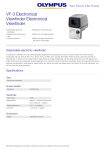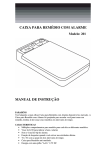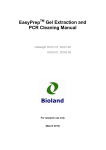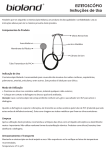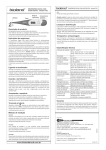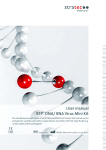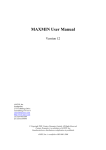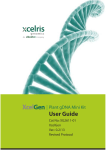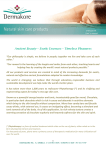Download EasyPrepTM Plant Genomic DNA Miniprep Manual
Transcript
Table of Contents EasyPrepTM Plant Genomic DNA Miniprep Manual Introduction.......................................................... 3 Kit Contents......................................................... 4 Protocols Catalog#: GD02-01, GD02-02 A. Fresh/Frozen Specimens.................................. 5 B. Dry Specimens................................................. 8 C. Plant rich in polyphenols or polysaccharides… 10 Troubleshooting Guide…………………………….. 11 For research use only (March 2013) 2 EasyPrepTM Genomic DNA Miniprep Introduction Important: The EasyPrep™ Plant genomic DNA Kit is designed for efficient recovery of genomic DNA up to 60 kb in size from fresh and dried plant tissue samples. Up to 100 mg of wet tissue (or 30 mg dry tissue) can be processed in less than 1 hour. The system combines the reversible nucleic acid-binding properties of the matrix with the speed and versatility of spin column technology to eliminate polysaccharides, phenolic compounds, and enzyme inhibitors from plant tissue lysates. Purified DNA is suitable for PCR, restriction digestion, and hybridization techniques. There are no organic extractions thus reducing plastic waste and hands-on time to allow multiple samples to be processed in parallel. 1. Dilute DNA Wash Buffer with absolute ethanol as follows and store at room temperature: Overview If using the EasyPrep™ Plant Genomic DNA Kit for the first time, please read this booklet to become familiar with the procedures. Samples are homogenized and lysed in a high salt buffer. The DNA is bound to the column while proteins and other impurities are removed by wash buffer. The purified DNA is suitable for downstream applications such as endonuclease digestion, thermal cycle amplification, and hybridization techniques. GD02-01 Add 80 mL absolute ethanol (96%-100%) GD02-02 Add 216 mL absolute ethanol (96%-100%) 2. Choose the most appropriate protocol to follow. Procedures are described for each of dried and fresh (or frozen) specimens. A. Dry Specimens (Page 5) For processing ≤ 50 mg powdered tissue. DNA yields range from 50 μg to 100 μg per 100 mg dry tissue. B. Fresh/Frozen Specimens (Page 8) For processing ≤ 200 mg fresh (or frozen) tissue. DNA yields range from 50 μg to 100 μg per 100 mg dry tissue. Kit Contents Catalog# GD02-01 GD02-02 50 250 Storage and stability DNA Columns All components of the EasyPrep™ Plant Genomic DNA Kit are stable for at least 24 months from date of purchase when stored at 22-25oC. During shipment, or storage in cool ambient conditions, precipitates may form in Buffer PL1 and Buffer PL2. It is possible to dissolve such deposits by Buffer PL1 40 mL 180 mL Buffer CP1 30 mL 130 mL Buffer PL2 12 mL 50 mL warming the solution at 37℃, though we have found that they do not interfere with overall performance. Buffer PL3 15 mL 200 mL RNase A 100 uL 500 uL Before Starting DNA Wash Buffer (5x) 20 mL 54 mL Prepare all components and get all necessary materials ready by examining this instruction booklet and become familiar with each steps. Elution Buffer 15 mL 60 mL User Manual 1 1 EasyPrepTM Genomic DNA Miniprep 3 4 EasyPrepTM Genomic DNA Miniprep 1. Collect ground plant tissue as described (start with 100 mg) in a 2.0 mL microcentrifuge tube and immediately add 600 μl Buffer PL1. Optional: Add 10 μl ß-mercaptoethanol and vortex vigorously. Make sure to disperse all clumps. A. Fresh/Frozen Specimens Before Start: Water bath equilibrated to 65 oC. Equilibrate sterile ddH2O or Elution Buffer at 65 oC. Use extreme caution when handling liquid nitrogen. TIP: Process in sets of four to six tubes: fill all tubes with liquid nitrogen, grind, and add Buffer PL1 and 2-mercaptoethanol; proceed to Step 2 before starting another set. As a starting point, use 100 mg tissue per tube. If yield and purity are satisfactory, increase to 200 mg. This protocol is suitable for most fresh or frozen tissue samples allowing more efficient recovery of DNA. However, due to the tremendous variation in water and polysaccharide content of plants, sample size should be limited to 200 mg. Best results are obtained with young leaves or needles. To prepare samples, collect tissue in a 1.5 mL or 2 mL microcentrifuge tube and freeze by dipping in liquid nitrogen with a pair of tweezers to fill the tube. Grind the tissue using disposable kontes pellet pestles, which are available from VWR (Cat# KT749521-0500). Alternatively, one can allow liquid nitrogen to evaporate and then store samples at 70℃ for later use. For critical work such as PCR and cloning, pestles are best used a single time then soaked in a dilute bleach solution immediately after use until cleaning. Disposable pestles may be autoclaved several times. For standard Southern analysis, the same pestle can be reused several times to grind multiple tissue samples by rinsing with ethanol and carefully wiping the surfaces clean between samples. 2. Incubate at 65°C for 10 min. Mix sample twice during incubation by inverting tube. Optional: If necessary, add 2 μl RNase A into the lysate before incubation to remove the RNA. 3. Add 140 μl Buffer PL2 and mix well by vortexing for 10s. Centrifuge at 11,000 rpm for 10 min. 4. Carefully transfer the supernatant to a clean 2.0 mL tube. Add 0.7 volume isopropanol. Mix well by vortexing for 5s and centrifuge at 12,000 x g for 2 min to precipitate the DNA. This step removes polysaccharides and improves DNA binding ability to the spin column. 5. Carefully decant the supernatant and discard, avoid dislodging the DNA pellet. Invert the tube on absorbance paper towel for 1 min to drain any residual ethanol. The pellet doesn’t have to be dry. 6. Add 300 µl preheated (65°C) ddH2O and vortex for 10s to mix the DNA well. A brief incubation at 65°C may help dissolve the DNA. 7. Add 150 µl of Buffer PL3 and 300 µl 96-100% ethanol, mix well by vortexing for 5s. A precipitation may form but does not interfere with the DNA binding to the column. 8. Transfer the sample to the column and centrifuge at 11,000 rpm for 1 min. Discard the flow-through and put the column back to the collection tube. EasyPrepTM Genomic DNA Miniprep 5 6 EasyPrepTM Genomic DNA Miniprep 9. Add 600 µl DNA Wash Buffer and centrifuge at 11,000 rpm for 20s. Discard the flow-through and put the column back to the collection tube. Repeat once. 10. Centrifuge the column with the lid open at 11,000 rpm for 1 min. This is critical for removing residual ethanol that may interfere with downstream applications. 11. Transfer column to a clean 1.5 mL tube. Add pre-warmed (65 oC) 100 μl Elution Buffer (or sterile ddH2O) and immediately centrifuge at 11,000 rpm for 1 min to elute DNA. Smaller volumes will significantly increase DNA concentration but give lower yields. Use of more than 200 μl of buffer for elution is not recommended. 12. Repeat Step 11 with another 100 μl Elution Buffer. This may be performed using another 1.5 mL tube to maintain a higher DNA concentration in the first eluate. Note: To increase DNA concentration, add Elution Buffer and incubate the column at 60-70 oC for 5 min before elution. Total DNA yields vary depending on type and quantity of sample. Typically, 10-50 μg DNA with an A260/A280 ratio of 1.7-1.9 can be isolated using 50 mg dried tissue. B. Dry Specimens Before start: Waterbath equilibrated to 65oC. Equilibrate sterile ddH2O or Elution Buffer at 65oC. This is the most robust method for isolation of total cellular (mitochondrial, chloroplast, and genomic) DNA. Yields are usually sufficient for several tracks on a Southern blot for RFLP mapping. Drying allows storage of field specimens for prolonged periods of time prior to processing. Samples can be dried overnight in a 45 ℃ oven, powdered, and stored dry at room temperature. To prepare dried samples, place ≦50 mg of dried tissue into a 2.0 mL microcentrifuge tube and grind using a pellet pestle. Disposable Kontes pestles work well and are available from VWR (Cat# KT749521-0500). For critical work such as PCR and cloning, pestles are best used a single time then soaked in a dilute bleach solution immediately after use until clean. Disposable pestles may be autoclaved several times. For standard Southern analysis, the same pestle can be reused several times to grind multiple tissue samples by rinsing with ethanol and wiping the surface clean between samples. A fine powder will ensure optimal DNA extraction and yield. Process four to six tubes as a group till Step 2 and start another set. 1. 1. To 10-50 mg powdered dry tissue, add 600 μl Buffer PL1 in a 2.0 mL microcentrifuge tube. Optional: Add 10 μl ß-mercaptoethanol and vortex vigorously to mix. Make sure to disperse all clumps. Tip: Process in sets of four to six tubes: grind, add Buffer PL1 and ßmercaptoethanol, and proceed to Step 2 before starting another set. Initially, do not exceed 50 mg dried tissue. Amount can be increased according to results. 2. Incubate at 65oC for 10 min. Mix sample twice during incubation by inverting tube. Optional: If necessary, add 2 μl RNase A into the lysate before incubation to remove the RNA. EasyPrepTM Genomic DNA Miniprep 7 8 EasyPrepTM Genomic DNA Miniprep 3. Add 200 μl Buffer PL2 and mix well by vortexing for 10s and incubate on ice for 5 min. Centrifuge at 11,000 rpm for 10 min. Note: To increase DNA concentration, add Elution Buffer and incubate the column at 60℃-70℃ for 5 min before elution. 4. Carefully transfer the supernatant to a clean 2.0 mL tube. Add 0.7 volume isopropanol. Mix well by vortexing for 5s. Centrifuge at 12,000 x g for 2 min to precipitate the DNA. This step removes polysaccharides and improves DNA binding ability to the spin column. 5. Carefully decant the supernatant and discard, avoid dislodging the DNA pellet. Inverting the tube on absorbance paper towel for 1 min to drain any residual ethanol. The pellet doesn’t have to be dry. 6. Add 300 µl preheated (65°C) ddH2O and vortex for 10s to mix the DNA well. A brief incubation at 65°C may help dissolve the DNA. 7. Add 150 µl of Buffer PL3 and 300 µl 96-100% ethanol, mix well by vortexing for 5s. A precipitation may form but does not interfere with the DNA binding to the column. 8. Transfer the sample to the column and centrifuge at 11,000 rpm for 1 min. Discard the flow-through and put the column back to the collection tube. 9. Add 600 µL DNA Wash Buffer and centrifuge at 11,000 rpm for 20s. Discard the flow-through and put the column back to the collection tube. Repeat once. Total DNA yields vary depending on type and quantity of sample. Typically, 10-50 μg DNA with an A260/A280 ratio of 1.7-1.9 can be isolated using 50 mg dried tissue. Protocol for DNA isolation from plants rich in polyphenols and/or polysaccharides. 1. Collect ground plant tissue (start with 100 mg) in a 2.0 mL microfuge tube and immediately add 500 μL Buffer CP1. 2. Incubate at 65℃ for 15 min. Mix sample twice during incubation by inverting tube. Optional: If necessary, add 2 μL of RNase into the lysate before incubation to remove the RNA. 3. Add 800 μLchloroform /Isoamyl alcohol (24:1) and vortex to mix. Centrifuge at ≧10,000 x g for 5 min. Carefully transfer 300 µL of superntant to a new tube making sure not to disturb the pellet or any precipitates. 4. Add 150 μL of Buffer P3 followed by 300 μL of absolute ethanol and vortex to obtain a homogenous mixture. A precipitate may form upon addition of ethanol; it will not interfere with DNA isolation. 5. 10. Centrifuge the column with the lid open at 11,000 rpm for 1 min. This step is critical for removing residual ethanol that may otherwise be interfere with downstream applications. Apply the entire sample to a DNA column with the collection tube. Centrifuge at 13,000 rpm for 1 min to bind DNA. Discard the flowthrough liquid and reuse the collection tube. Continue to Step 9 on Page 9. 11. Transfer column to a clean 1.5 ml tube. Add pre-warmed (65 oC) 100 μl Elution Buffer (or sterile ddH2O) and centrifuge at 11,000 rpm for 1 min to elute DNA. Smaller volumes will significantly increase DNA concentration but give lower yields. Use of more than 200 μL of buffer for elution is not recommended. 12. Repeat with another 100 μl Elution Buffer. This may be performed using another 1.5 mL tube. EasyPrepTM Genomic DNA Miniprep 9 10 EasyPrepTM Genomic DNA Miniprep Trouble Shooting Guide Problems Clogged column Possible reasons Carry-over of debris. Make sure no particulate material is transferred. Sample too Do not exceed suggested amount of starting material. Alternatively, increase amounts of Buffers PL1 and PL2 and use two or more viscous Low DNA yield Suggestions Incomplete disruption of starting material Poor lysis of sample For both dry and fresh samples, obtain a fine homogeneous powder before adding Buffer PL1. Decrease amount of starting material or increase amount of Buffers PL1, PL2 and PL3 DNA remains Increase elution volume to 200 μL bound to column and incubate on column at 65oC for 5 min before centrifugation. DNA washed off Problems in downstream applications Salt carry-over Ethanol carry-over Dilute Wash Buffer Concentrate by adding appropriate volume of absolute ethanol prior to use ( page 4 ). Bioland Scientific LLC DNA Wash Buffer must be at room temperature. 14925 Paramount Blvd., Suite C Following the second wash spin, ensure that the column is dried by centrifuging 2 min at maximum speed. USA Paramount, CA 90723 Tel: (877) 603-8882 Fax: (562) 733-6008 Email: [email protected] [email protected] Visit our web at www.bioland-sci.com and learn more about Bioland products EasyPrepTM Genomic DNA Miniprep 11








